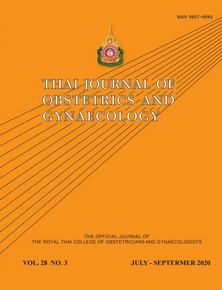The Outcomes of Ampicillin Plus Azithromycin to Prolong Latency Period in Preterm Premature Rupture of Membranes between 24 and 33+6 weeks of gestation in King Chulalongkorn Memorial Hospital
Main Article Content
Abstract
Objective: To determine the success rate of ampicillin plus azithromycin to prolong the latency period in cases with preterm premature rupture of membranes (PPROM).
Materials and Methods: A retrospective descriptive study was conducted. Medical records of singleton pregnancies between 24 and 33+6 weeks of gestation who complicated with PPROM and received ampicillin and oral azithromycin to prolong the latency period in King Chulalongkorn Memorial Hospital between January 2010 and December 2016 were reviewed. Prolonged latency period more than 48 hours was defined as success. Descriptive statistics were used for data analysis.
Results: Eighty eight pregnancies were included in the study with mean age of 30.4 ± 5.6 years and mean gestational age of 31.3 ± 2.5 weeks. The median of latency period was 96 hours (IQR 60-192 hours) and 76 cases (86.4%) reached more than 48 hours of latency period. Seven women (8.0%) complicated by chorioamnionitis with 1 case of maternal sepsis. Regarding neonatal outcomes, respiratory distress syndrome (RDS) complicated in 29 neonates (33.0%) and 12 cases (13.6%) needed ventilator. Forty eight cases (54.5%) found neonatal sepsis along with 3 (3.4%) neonatal deaths.
Conclusion: Antibiotic regimen including ampicillin and azithromycin is effective to prolong latency period in most women presented with PPROM. However, one-third of the neonates complicated with RDS and neonatal sepsis was found in more than half of the cases. Further study is needed to identify regimens that may improve neonatal outcomes.
Article Details
References
Purisch SE, Gyamfi-Bannerman C. Epidemiology of preterm birth. Semin Perinatol 2017;41:387-91.
Blencowe H, Cousens S, Oestergaard MZ, Chou D, Moller AB, Narwal R, et al. National, regional, and worldwide estimates of preterm birth rates in the year 2010 with time trends since 1990 for selected countries: a systematic analysis and implications. Lancet 2012;379:2162-72.
DiGiulio DB, Romero R, Kusanovic JP, Gómez R, Kim CJ, Seok KS, et al. Prevalence and diversity of microbes in the amniotic fluid, the fetal inflammatory response, and pregnancy outcome in women with preterm pre-labor rupture of membranes. Am J Reprod Immunol 2010;64:38-57.
Romero R, Miranda J, Chaemsaithong P, Chaiworapongsa T, Kusanovic JP, Dong Z, al. Sterile and microbial-associated intra-amniotic inflammation in preterm prelabor rupture of membranes. J Matern Fetal Neonatal Med 2015;28:1394-409.
Manorompattarasan R, Kunpalin Y, Chaithongwongwatthana S. Neonatal survival rate following premature rupture of membranes at gestational age 15-30 weeks. Thai J Obstet Gynaecol 2017;25:88-94.
Clark EA, Varner M. Impact of preterm PROM and its complications on long-term infant outcomes. Clin Obstet Gynecol 2011;54:358-69.
Kenyon S, Boulvain M, Neilson JP. Antibiotics for preterm rupture of membranes. Cochrane Database Syst Rev 2013;12:CD001058.
National Institute for Health and Care Excellence. Preterm labour and birth. (NICE guideline 25) 2015. Available at: http://nice.org.uk/guidance/ng25.
Yudin MH, van Schalkwyk J, Van Eyk N. No. 233-Antibiotic therapy in preterm premature rupture of the membranes. J Obstet Gynaecol Can 2017;39: e207-12.
Committee on Practice Bulletins-Obstetrics. ACOG Practice Bulletin No. 188: Prelabor rupture of membranes. Obstet Gynecol 2018;131:e1-e14.
Rapp RP. Pharmacokinetics and pharmacodynamics of intravenous and oral azithromycin: enhanced tissue activity and minimal drug interactions. Ann Pharmacother 1998;32:785-93.
Parnham MJ, Erakovic Haber V, Giamarellos-Bourboulis EJ, Perletti G, Verleden GM, Vos R. Azithromycin: mechanisms of action and their relevance for clinical applications. Pharmacol Ther 2014;143:225-45.
Azithromycin: pharmacokinetics. In Micromedex. Greenwood Village, CO: Truven Health Analytics. Available at: http://www.micromedexsolutions.com.
Borgida AF, Mills AA, Feldman DM, Rodis JF, Egan JF. Outcome of pregnancies complicated by ruptured membranes after genetic amniocentesis. Am J Obstet Gynecol 2000;183:937-9.
Daniel WW. Biostatistics: a foundation for analysis in the health sciences, 9th ed. New Jersey: John Wiley & Sons, Inc 2009:192.
Phupong V, Kumala L. Clinical course of preterm prelabor rupture of membranes in the era of prophylactic antibiotics. BMC Res Notes 2012;5:515.
Waters TP, Mercer B. Preterm PROM: prediction, prevention, principles. Clin Obstet Gynecol 2011;54: 307-12.
Pierson RC, Gordon SS, Haas DM. A retrospective comparison of antibiotic regimens for preterm premature rupture of membranes. Obstet Gynecol 2014;124:515-9.
Finneran MM, Appiagyei A, Templin M, Mertz H. Comparison of azithromycin versus erythromycin for prolongation of latency in pregnancies complicated by preterm premature rupture of membranes. Am J Perinatol 2017;34:1102-7.
Finneran MM, Smith DD, Buhimschi CS. Cost analysis of azithromycin versus erythromycin in pregnancies complicated by preterm premature rupture of membranes. Am J Perinatol 2019;36:105-10.


